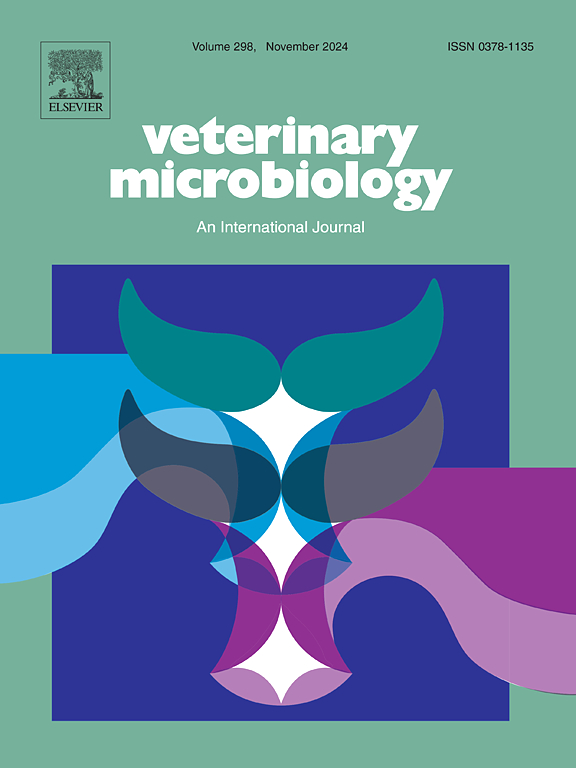核心基因组多位点序列分型(cgMLST)显示了necrophorum Fusobacterium ssp的群体特异性。芬兰奶牛指间痰暴发分离的necrophorum
IF 2.4
2区 农林科学
Q3 MICROBIOLOGY
引用次数: 0
摘要
2010年代,芬兰全国奶牛群中发生了多起指间痰(IP)暴发,导致显著但不同的发病率和严重的临床症状。这些疫情增加了抗生素的使用,给受影响的农场造成了经济损失。在2012-2015年期间,我们对19个受IP影响的农场的IP暴发进行了流行病学、临床表现和细菌学研究。此外,我们还收集了来自IP奶牛的坏死梭杆菌分离株,以供进一步研究。在这里,我们使用全基因组测序(WGS)分析了来自7个猪群的25个早期IP分离株,这些猪群具有中度和高发病率。我们的目的是确定是否一种新的传染性坏死乳杆菌菌株在畜群之间传播,导致暴发,以及分离株是否具有抗生素耐药性或已知的主要毒力基因。芬兰的F. necrophorum。Necrophorum分离物聚集成7个不同的群体,每个群体对应于起源群体。因此,来自高发病率和中等发病率畜群的分离株也没有聚集在一起。我们的分析显示,尽管对治疗的临床反应不一致,但在分离株中没有已知的抗生素耐药基因。所有分离株均含有白毒素和溶血素毒力基因,但不含粘附素。我们不仅鉴定出一种新的传染性菌株,还鉴定出了necrophorum ssp的群体特异性菌株。芬兰奶牛群中IP奶牛的necrophorum。因此,芬兰IP暴发的原因尚不清楚,值得进一步研究。本文章由计算机程序翻译,如有差异,请以英文原文为准。
Core genome multilocus sequence typing (cgMLST) indicates herd specificity of Fusobacterium necrophorum ssp. necrophorum isolated from dairy cattle interdigital phlegmon outbreaks in Finland
Numerous outbreaks of interdigital phlegmon (IP) occurred in Finnish dairy herds country-wide in the 2010s, resulting in significant but varying morbidity and severe clinical signs. These outbreaks increased antibiotic use and caused financial losses on the affected farms. During 2012–2015, we performed a study on the epidemiology, clinical presentation and bacteriology of IP outbreaks on 19 IP-affected farms. In addition, we collected Fusobacterium necrophorum isolates from IP cows for further studies. Here, we present an analysis of 25 isolates from early-stage IP from seven herds representing both moderate and high morbidity using whole genome sequencing (WGS). Our aim was to determine whether a novel contagious F. necrophorum strain had spread between the herds, causing the outbreaks, and whether the isolates possessed antibiotic resistance or known major virulence genes in silico. The Finnish F. necrophorum ssp. necrophorum isolates clustered into seven different groups, each corresponding to the herd of origin. Therefore, the isolates from high and moderate morbidity herds did not cluster together either. Our analysis revealed no known antibiotic resistance genes in the isolates, despite the clinical response to treatment being inconsistent. All isolates harboured virulence genes for leukotoxin and haemolysin but were devoid of adhesin. Instead of only one novel contagious strain, we identified herd-specific strains of F. necrophorum ssp. necrophorum in IP cows from Finnish dairy cattle herds. Therefore, the cause of IP outbreaks in Finland remains unknown and merits further research.
求助全文
通过发布文献求助,成功后即可免费获取论文全文。
去求助
来源期刊

Veterinary microbiology
农林科学-兽医学
CiteScore
5.90
自引率
6.10%
发文量
221
审稿时长
52 days
期刊介绍:
Veterinary Microbiology is concerned with microbial (bacterial, fungal, viral) diseases of domesticated vertebrate animals (livestock, companion animals, fur-bearing animals, game, poultry, fish) that supply food, other useful products or companionship. In addition, Microbial diseases of wild animals living in captivity, or as members of the feral fauna will also be considered if the infections are of interest because of their interrelation with humans (zoonoses) and/or domestic animals. Studies of antimicrobial resistance are also included, provided that the results represent a substantial advance in knowledge. Authors are strongly encouraged to read - prior to submission - the Editorials (''Scope or cope'' and ''Scope or cope II'') published previously in the journal. The Editors reserve the right to suggest submission to another journal for those papers which they feel would be more appropriate for consideration by that journal.
Original research papers of high quality and novelty on aspects of control, host response, molecular biology, pathogenesis, prevention, and treatment of microbial diseases of animals are published. Papers dealing primarily with immunology, epidemiology, molecular biology and antiviral or microbial agents will only be considered if they demonstrate a clear impact on a disease. Papers focusing solely on diagnostic techniques (such as another PCR protocol or ELISA) will not be published - focus should be on a microorganism and not on a particular technique. Papers only reporting microbial sequences, transcriptomics data, or proteomics data will not be considered unless the results represent a substantial advance in knowledge.
Drug trial papers will be considered if they have general application or significance. Papers on the identification of microorganisms will also be considered, but detailed taxonomic studies do not fall within the scope of the journal. Case reports will not be published, unless they have general application or contain novel aspects. Papers of geographically limited interest, which repeat what had been established elsewhere will not be considered. The readership of the journal is global.
 求助内容:
求助内容: 应助结果提醒方式:
应助结果提醒方式:


